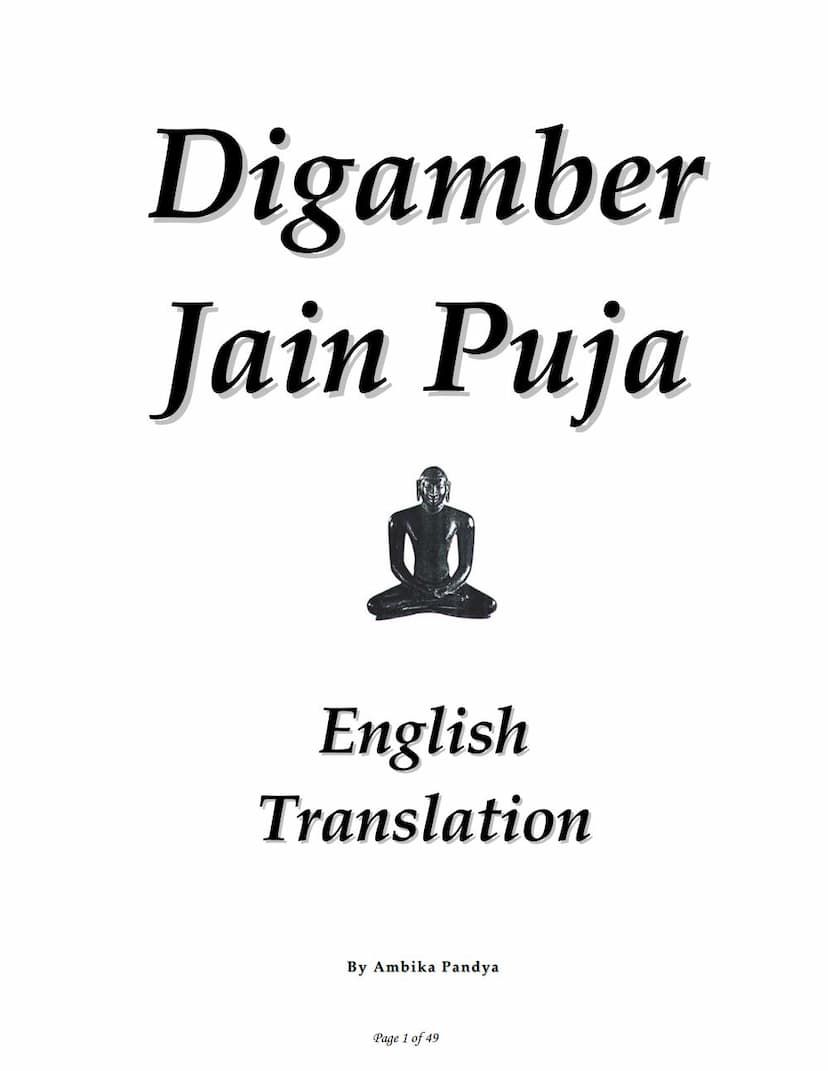Digambar Jain Pooja English
Added to library: September 1, 2025

Summary
This document, "Digambar Jain Pooja English," authored by Ambika Pandya and published by Ambika Pandya, serves as a comprehensive guide to the rituals and prayers associated with Digambar Jain worship. It provides an English translation of various Jain devotional texts and practices, making them accessible to a wider audience.
The book begins with a foundational explanation of the Digambar Puja (worship) and its significance within Jainism, highlighting it as a primary daily essential. It details the prescribed rituals before visiting a temple, including bathing, wearing clean clothes, observing non-violence, washing hands and feet, and chanting specific mantras upon entry.
A core section of the text is dedicated to the Namokar Mantra, the most sacred mantra in Jainism, along with its transliteration and English meaning, emphasizing its power to destroy sins and obstacles. The book also lists the Names of the 24 Tirthankaras and their respective symbols, offering a visual and symbolic representation of these enlightened beings.
The Jain Symbols are then explained in detail, including the Jain Shashan flag, the Jain flag with its color symbolism, the meaning of the Three Jewels (Samyak Darshan, Samyak Jnan, Samyak Charitra) represented by the three dots, and the comprehensive meaning of the main Jain symbol which depicts the universe, Ahimsa, the cycle of rebirth, and the ultimate goal of liberation. Various sacred syllables like AUM, HRIM, and ARHIM are also discussed, along with their significance. The Ashtamangal (eight auspicious symbols) and the concept of Kalchakra (wheel of time) are also elaborated upon.
The subsequent sections delve into specific puja rituals and prayers:
- Jal Abhishek Path: Prayers for bathing the idol, emphasizing purity of mind and body.
- Shanti Dhara: Prayers for peace and well-being for all beings.
- Prabhu Patitha Pavan: A prayer acknowledging the Tirthankaras' power to purify the fallen.
- Vinay Paatth: A devotional recitation expressing reverence and seeking the Tirthankaras' blessings for liberation from worldly suffering.
- Pooja Prarambh: The commencement of the puja, including the chanting of the Namokar Mantra and other auspicious verses.
- Pooja Pratigya Paatth: A declaration of commitment to performing the puja with proper intention and devotion.
- Swasti Mangal Paatth: Auspicious verses seeking well-being and prosperity.
- Aarghas: Offerings made with various substances, with specific prayers for each of the 24 Tirthankaras, Bahubali Bhagvan, Nandiswardeep, Ratnatraya, Das Lakshana, Sapthrishi, Nirvana, Saraswati, and Vidyasagarji.
- Shanti Paatth: Prayers for universal peace and well-being, particularly invoking Shantinath Bhagvan.
- Shanti Paatth Visarjan: Prayers for the conclusion of the puja, seeking forgiveness for any omissions and bidding farewell to celestial beings.
- Samucchchaya Pooja: A collective puja dedicated to the Deva, Shastra, Guru, the Tirthankaras, and the Siddhas, performed with the eight substances (Ashtadravya).
- Navdevtha Pooja: Worship of the nine supreme beings in Jainism: the Panch Parmeshthi (Arihant, Siddha, Acharya, Upadhyaya, Sadhu), Jin Dharma, Jin Aagam, Jin Chetya, and Jin Chetyalaya.
- Das Lakshana Pooja: Worship dedicated to the ten virtues: forbearance, humility, honesty, purity, truthfulness, self-restraint, penance, renunciation, detachment, and chastity.
- Sohlakaran Pooja: Worship of the sixteen auspicious factors (Sohla Karan Bhavna) that lead to spiritual progress.
- Panchmeru Pooja: Worship of the five sacred mountains in Jain cosmology, which are believed to be adorned with Tirthankara temples.
- Mahaveer Bhagwan Pooja: A specific puja dedicated to Lord Mahaveer, the 24th Tirthankara, highlighting his life and teachings.
The book concludes with Aartis dedicated to the Panch Parmeshthi (the five supreme beings), Lord Mahaveer, and Adinath Bhagwan (the first Tirthankara). These aartis are sung with devotion to conclude the worship.
In essence, "Digambar Jain Pooja English" provides a comprehensive and accessible resource for understanding and performing Jain worship, encompassing its theological underpinnings, symbolic representations, and the practical aspects of devotional practices. It aims to foster spiritual growth and a deeper connection with the principles and exemplars of Jainism.